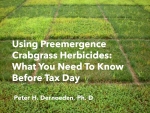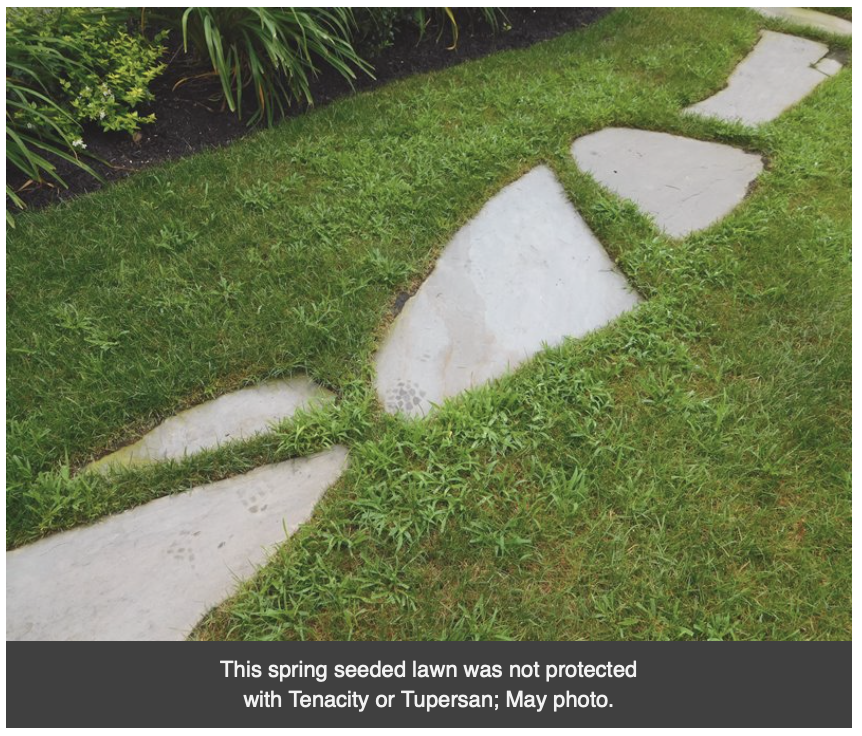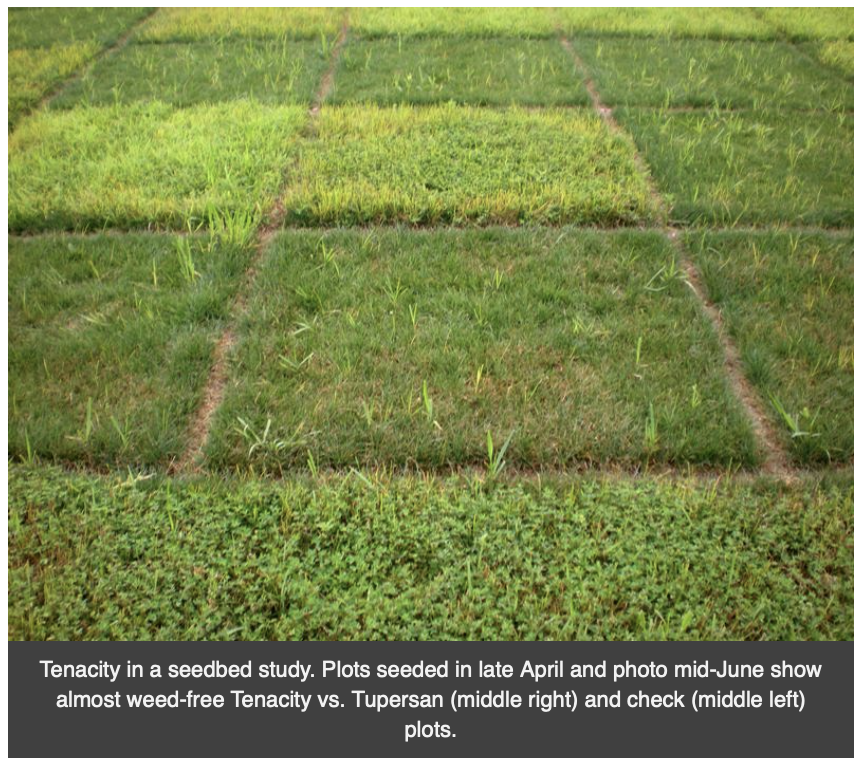
Peter H. Dernoeden, Ph.D

Crabgrass is the most common and invasive turfgrass weed in the mid-Atlantic. Most professional turf managers in our region are well versed on the importance of premergence crabgrass control, since postemergence control is much more difficult and expensive. Most have learned from experience what works best for them. Fortunately, our industry is growing, and there always are new employees reaching-out to learn and gain experience with best management practices.
If you think there is something new in terms of improved herbicides and secret methods of dealing with crabgrass –you would be wrong. Overtime, however, even the most experienced pro needs a refresher on how these herbicides work, the nature of emergence and herbicide application timings, as well as the many cultural and environmental influences on premergence herbicide performance. Smooth, hairy and southern crabgrasses can be found in the mid-Atlantic, but smooth crabgrass dominates. Regardless of species, they have similar characteristics and are controlled by the same herbicides. Unabated, crabgrass forms massive and dense numbers of leaves, tillers and spiked seedheads. The aggressive habits of crabgrass in combination with poor cultural practices allows it to dominate out-compete and replace cool-season grasses. Culturally, crabgrass dominance is most influenced by mowing too low and poor nitrogen fertility.


Crabgrass typically begins germinating April 15 (tax day) ± 7 days in the Washington DC-Philadelphia corridor, but most germination occurs when soil temperatures exceed 68oF. There are two major flushes of crabgrass emergence in mid-May and again mid-June. Spring droughts hinder seedling emergence and development. In the so-called typical year, most crabgrass seedlings emerge by mid-July, but germination will continue all summer if soils are moist. Summer rain events can stimulate a considerable amount of seedling emergence into September. Plants tiller rapidly during hot weather and frequent rain events accelerate tillering (i.e., lateral shoots) and spread. Under conditions of poor turf density, crabgrass plants can produce 30 or more spreading tillers; plants become firmly anchored in soil and become difficult to remove by hand. Low mowing, low nitrogen fertility and wet soils in summer can enable crabgrass to dominate a turfgrass stand in as little as two years.


The easiest, most effective and economical approach to crabgrass control is through the application of a premergence herbicide. Commonly used preemergence herbicides include Barricade (prodiamine), Dimension (dithiopyr), Pendulum (pendimethalin) and Ronstar (oxadiazon). There also are pre-packaged mixtures: Team Pro (benefin + trifluralin) and Echelon (prodiamine + sulfentrazone). To be effective, these materials should be applied about two weeks prior to the time crabgrass seed germination is anticipated (i.e., crabgrass emergence in turf is normally mid-April ± 5 days in our region), but earlier applications (i.e., February or March) when soils are cold also work well. All of these materials require a timely rain within a few days to provide maximum control. Preemergence herbicides do not kill seeds in the soil. Germinating weed seeds absorb the herbicide, which prevents root and shoot development. The mid-Atlantic is known as the “crabgrass belt” and thus rates are important because of its ability to dominate here. Where crabgrass exists in relatively low levels, one should expect effective control at the high label rate in a single application in our region. Where crabgrass pressure is chronically high , it is best to use split applications. For example, if the high label rate is 1.0 lb ai/A, you should split the rate and apply 0.5 lb ai/acre in the first application and a second application of 0.5 lb ai/acre should follow in 6 to 8 weeks.



Cultural Crabgrass Managements Measures That Work: Proper use of nitrogen (N) fertilizers and mowing high within the recommended range (usually 2.5-3.0” for lawns and roughs) dramatically reduces the ability of crabgrass to germinate and compete. Nitrogen is so important since it promotes dense turfs that greatly retard crabgrass seed germination and seedling survival. Use of N along with “pre” also has been shown to greatly reduce crabgrass invasion. Basically, it is recommended to use a slow release N (e.g., coated urea’s, natural organics) in the autumn in cool-season grasses. Normally, it is best to use a water-soluble fast release N source (e.g. urea and ammonium sulfate) in the spring at about the time a “pre” is applied. The fast release N does a better job in waking the turf-up in spring to get it growing and competitive against weeds. Finally, maintaining enough soil moisture in summer to prevent wilt and drought damage in lawns will further reduce crabgrass invasiveness. Lawns allowed to go drought dormant have no means of competing against weed emergence, growth and results in enhanced weeds seed production. Once a large crabgrass seedbank builds in soils, the weed becomes a perpetual problem.


Why do premergence herbicides sometime fail? Some simple reasons include : herbicides applied after crabgrass has already germinated in large numbers (i.e., after mid-May); improper rate: failure to use split applications where crabgrass pressure was high in previous years; “hot spots’ on slopes, adjacent to sidewalks, driveways, etc.; spring droughts that delay crabgrass emergence and cause dissipation of effective herbicide levels; poor/improper sprayer calibration; skips; applications made on windy days and/or uneven terrain; mowing too soon after applications, and before rain, which removes some active ingredient adhering to clippings.
More likely scenarios deal with factors that enhance herbicide degradation. These herbicides are programmed (i.e., via rate/ai studies) to dissipate in soil by late summer in the event summer damaged areas require overseeding. The major reason for more rapid than normal dissipation occurs in response to soaking rain events or excessive irrigation in July and August. Moist soils in summer will accumulate and store heat faster, which speeds herbicide degradation via enhanced microbial activity (i.e., bacteria use herbicides as energy sources and their activity is enhanced in warm and wet soils). Concomitantly, late summer rains stimulate more crabgrass seed germination, promote rapid tillering, invasiveness and seedhead production.
Some Thoughts on Goosegrass:
Goosegrass begins germination shortly (2 or 3 weeks) after crabgrass and intensifies when soils become warmer and hot. The only highly effective goosegrass-targeted preemergence herbicide, which is safe to use on cool-season grasses, is RonStar (expensive and only available in granular form). All others do reduce goosegrass significantly, but where goosegrass pressure is intense they do not hold-up. For unknown reasons, goosegrass is simply much more sensitive to RonStar. From Virginia and south, RonStar resistant-goosegrass has become a major issue in bermudagrass fairways. The advent of Specticle (indaziflam) has become the solution. Specticle is highly effective on both crabgrass and goosegrass (as well as annual bluegrass in late summer apps), but only is safe to apply to bermudagrass and zoysiagrass. Caution is warranted on its’ use, since the herbicide can move in surface water drainage patterns and severely injure adjacent cool-season-grasses
Some Suggestions of Spring Seedings: After the seedbed has been prepared, it is very important to apply a seedbed-safe preemergence herbicide like Tenacity (mesotrione) or Tupersan (siduron).The reason being is that the most common cause for spring seeding failures comes from weed competition. While Tupersan is highly effective on crabgrass and foxtails, it has little or no impact on broadleaf weeds or sedges. Tenacity has been a major game changer in successful spring seeding’s because it safely targets a multitude of common broadleaf and sedge weeds as well as crabgrass. For best results, apply Tenacity at seeding (or shortly thereafter) and then a second time 4 to 6 weeks later. It works wonders in reducing weed completion, thus allowing seedlings to tiller and for stands to mature more rapidly.


Thanks for reading! For more articles and information, visit the Dr. Pete's Turf Tips Archive.
 Dr. Pete's Turf Tips
Dr. Pete's Turf Tips